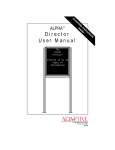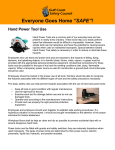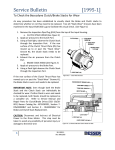Download Lockout Policy and Procedure
Transcript
Lockout Policy and Procedure ___________________________________________________________________________________ Name of your Company Lockout procedure for (Name of equipment)__________________________________________________________________ Purpose This procedure establishes the minimum requirements for lockout of energy sources that could cause injury to personnel. All workers shall comply with this procedure. Responsibility The responsibility for seeing that this procedure is followed is binding upon all workers. All workers shall be instructed in the safety significance of the lockout procedure by (designated individual). Each new or transferred affected employee shall be instructed by (designated individual) in the purpose and use of the lockout procedure. Preparation for Lockout Workers authorized to perform lockout shall be certain as to which switch, valve, or other energy isolating devices apply to the equipment being locked out. More than one energy source (electrical, mechanical, or others) may be involved. Any questionable identification of sources shall be cleared by the worker with their supervisors. Before lockout commences, job authorization should be obtained. Sequence of Lockout Procedure 1. Notify all affected workers that a lockout is required and the reason therefore. 2. If the equipment is operating, shut it down by the normal stopping procedure (such as: depress stop button, open toggle switch). 3. Operate the switch, valve, or other energy isolating devices so that the energy source(s) (electrical, mechanical, hydraulic, and other) is disconnected or isolated from the equipment. Stored energy, such as that in capacitors, springs, elevated machine members, rotating fly wheels, hydraulic systems, and air, gas, steam or water pressure, must also be dissipated or retained by methods such as grounding, repositioning, blocking, or bleeding down. 4. Lockout energy isolating devices with an assigned individual lock. 5. After ensuring that no personnel are exposed and as a check on having disconnected the energy sources, operate the push button or other normal operating controls to make certain the equipment will not operate. CAUTION: Return operating controls to neutral position after the test (if test fails do not attempt to operate or continue with lockout; notify your supervisor). 6. The equipment is now locked out. Lockout Policy and Procedure Restoring Equipment to Service 1. When the job is complete and equipment is ready for testing or normal service, check the equipment area to see that on one is exposed. 2. When equipment is clear, remove all locks. The energy isolating devices may be operated to restore energy to equipment. Procedure Involving More Than One Person In the preceding steps, if more than one individual is required to lock out equipment, each shall place his/her own personal lock on the energy isolating device(s). One designated individual of a work crew or a supervisor, with the knowledge of the crew, may lock out equipment for the whole crew. In such cases, it may be the responsibility of the individual to carry out all steps of the lockout procedure and inform the crew when it is safe to work on the equipment. Additionally, the designated individual shall not remove a crew lock until it has been verified that all individuals are clear. Rules for Using Lockout Procedure All equipment shall be locked out to protect against accidental or inadvertent operation when such operation could cause injury to personnel. Do not attempt to operate any switch, valve, or other energy isolating device bearing a lock. Name: ________________________________________________________________________ Date: _________________________________________________________________________ Revision Date: __________________________________________________________________ Lockout Policy and Procedure LOCK/TAG OUT PROCESS Definition The process of securing a hazard to eliminate risk and to provide temporary guarding of a machine or process. LOTO provides for a system of protection against all electrical and mechanical hazards. Examples Power circuits. Reciprocating machinery. Pressure vessels. All other equipment (electrical, mechanical, hydraulic, etc) that could cause a potential hazard. Electrical Safety Every year about 4000 work accidents involving electric shock or electrical burns are reported. About 100 of these are fatal. Apart from road accidents electrical safety was the biggest Global cause of fatalities in last decade in the commercial sector. Controlled by Regulations. Applies to all electrical systems. Principal concern is high voltages defined as those above 110 volts. LOTO process involves locking out the main power switch. LOTO process involves clear marking of the main power switch to ensure that any third party is aware of the hazard. LOTO process involves ensuring that all energy is dissipated before contact (e.g. capacitors). Mechanical Safety Controlled by Regulations. Requirement for all work equipment to be guarded. Requirement for training prior to any work being performed. Requirement for maintenance and record keeping. Mechanical Hazards Lockout Policy and Procedure Prime movers. In-running nip. Reciprocating movement. Drive belts. Rotating parts. Pneumatic and hydraulic operations. Mechanical Safety LOTO process involves locking out the main power or control switch. LOTO process involves clear marking of the main power or control switch to ensure that any third party is aware of the hazard. LOTO process involves ensuring that no further movement can occur. Job Safety Analysis Risk assessment Identify hazards. Calculate risk rating. Document controls. Lockout Policy and Procedure LOCK OUT PROCEDURES AUTHORISED EMPLOYEES ONLY Insert Equipment Type Notify Employees Affected workers will be notified of lockout activities verbally by authorized employee(s) prior to and during implementation of lock / tag out procedures. Authorized workers include: Insert Names Shut Down Equipment Review the Operator/Service manual(s) for any special shut down or maintenance instructions. Perform normal shut down procedure at control panel and turn power selection to the “off” position. Operate Energy Isolating Device Operate the main power breaker. Operate any pneumatic valve when servicing these items. Apply LOTO Device Authorized workers apply LOTO measures to the power isolating devices mentioned above. Dissipate/restrain Stored Energy Perform energy dissipation procedures for any internal capacitors. Bleed down any remaining pressure at disconnect points for lines. Verify Disconnect After ensuring that no workers are exposed to potential injury, and having disconnected all energy sources (LOTO), operate the power activation controls to verify that the equipment will not operate. Perform Maintenance Return the operating control to “neutral” or “off” after the verification test. Perform necessary maintenance tasks on the equipment. Check Area After the servicing is complete and the equipment or machine is ready for normal operations, check the area around the equipment to ensure that no one is exposed to danger and all tools have been removed prior to re-energizing. Remove LOTO Devices - Start-up Perform housekeeping check, reinstall guards, and ensure that all personnel are clear of the equipment. Remove LOTO devices. Restore energy to the equipment and verify safe operation.










